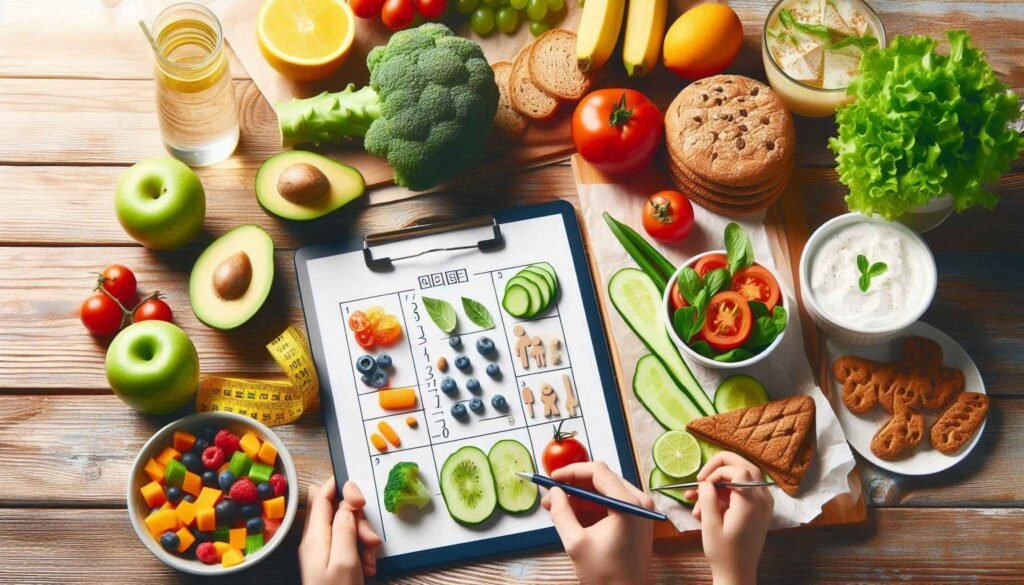
Eating well as a family isn’t just about getting the right nutrients—it’s about building lifelong habits, enjoying time together, and taking charge of your health. A well-thought-out family meal plan ensures everyone gets the nutrients they need while cutting down on the stress of last-minute cooking decisions. Plus, it saves time, reduces waste, and keeps everyone satisfied!
Let’s dive into how you can create a nutritious, balanced, and enjoyable meal plan for your entire family.
1. The Basics of Family Nutrition
To create a healthy meal plan for the whole family, it’s essential to understand each family member’s nutritional needs. Every age group, from children to adults, has different dietary requirements. Kids need adequate amounts of proteins, fats, and carbohydrates to support their growth, while adults benefit from nutrient-dense foods that support heart health, energy, and disease prevention.
A balanced family meal plan should cover:
- Protein: Lean meats, fish, eggs, beans, lentils, tofu, and dairy products. Protein helps build and repair tissues and supports immune function.
- Healthy Fats: Olive oil, avocados, nuts, seeds, and fish like salmon. These fats support brain function and overall well-being.
- Carbohydrates: Whole grains, oats, brown rice, sweet potatoes, and quinoa. Choose complex carbs that provide sustained energy.
- Fruits and Vegetables: Aim for a variety of colors to ensure a wide range of vitamins and minerals. Think of the plate as a rainbow—greens like spinach, reds like bell peppers, and purples like eggplant are all important.
- Dairy or Dairy Alternatives: Milk, yogurt, cheese, or calcium-fortified plant-based alternatives contribute to bone health.
2. Portion Control: Quality Over Quantity
When it comes to portion sizes, the plate method is an effective guide. For a balanced plate:
- Half of the plate should be vegetables and fruits. These provide essential vitamins, minerals, and fiber.
- A quarter of the plate should be protein. Lean proteins like chicken, fish, or plant-based options are great choices.
- A quarter should be whole grains or complex carbohydrates. Whole-wheat bread, quinoa, or brown rice add energy-sustaining nutrients.
Portion control isn’t just about limiting food but about ensuring the right amount to fuel your body without overconsumption. Teaching children about serving sizes is also an excellent way to help them develop a healthy relationship with food.
3. Plan Balanced Meals for the Week
A weekly meal plan helps avoid mealtime chaos. Creating a schedule reduces the guesswork and helps in efficient grocery shopping.
Monday
- Breakfast: Overnight oats with chia seeds, topped with berries and a drizzle of honey.
- Lunch: Whole-grain wrap with grilled chicken, spinach, tomatoes, and a dollop of Greek yogurt.
- Dinner: Baked salmon with a lemon-dill sauce, quinoa, and roasted asparagus.
- Snack: Apple slices with almond butter.
Tuesday
- Breakfast: Smoothie made with bananas, spinach, almond milk, and peanut butter.
- Lunch: Quinoa salad with chickpeas, cucumber, cherry tomatoes, feta cheese, and a lemon vinaigrette.
- Dinner: Turkey and veggie stir-fry with bell peppers, broccoli, and brown rice.
- Snack: Mixed berries and a handful of nuts.
4. Smart Grocery Shopping Tips
Having a solid meal plan makes grocery shopping more efficient, reducing waste and saving money. Here are some tips:
- Shop the Perimeter: The perimeter of the grocery store is usually where fresh produce, meats, and dairy are located. Focus on these areas and avoid highly processed foods in the center aisles.
- Read Labels: If buying packaged foods, read labels for added sugars, sodium, and trans fats. Opt for items with minimal ingredients that you recognize.
- Stick to the List: Prepare your grocery list based on your meal plan. This helps in avoiding impulse buys, which are often unhealthy and unnecessary.
5. Making Meals Fun for Kids
Getting kids involved in meal planning and preparation is a great way to introduce them to healthy eating habits. Here are some ideas:
- Create a “Build-Your-Own” Night: Whether it’s tacos, pizza, or grain bowls, letting kids customize their meals gives them a sense of control and encourages them to try different ingredients.
- Colorful Plates: Kids are more likely to eat a meal that looks fun. Use a variety of colorful vegetables and fruits to make plates appealing.
- Name the Dishes: Rename dishes to make them more exciting—“Superhero Salad” or “Rainbow Veggie Stir-Fry” adds an element of playfulness.
6. Healthy Swaps to Make Meals More Nutritious
- Swap white rice for quinoa or brown rice for added fiber and protein.
- Replace sugary cereals with oatmeal topped with fruit and nuts.
- Use Greek yogurt instead of sour cream for a protein-rich, creamy topping.
- Choose whole-wheat bread, pasta, and tortillas over refined versions for added fiber.
7. Quick and Easy Family-Friendly Recipes
Keeping recipes simple and quick makes sticking to a healthy meal plan easier, especially during busy weekdays.
Chicken and Veggie Sheet Pan Bake
- Ingredients: Chicken breast, bell peppers, zucchini, cherry tomatoes, olive oil, garlic, and Italian seasoning.
- Instructions: Preheat the oven to 400°F (200°C). Place chicken and veggies on a baking sheet. Drizzle with olive oil, sprinkle with garlic and seasoning, and bake for 25-30 minutes until the chicken is cooked through. Serve with quinoa or brown rice.
Whole-Wheat Pita Pizzas
- Ingredients: Whole-wheat pita, tomato sauce, shredded mozzarella cheese, assorted veggies (like bell peppers, mushrooms, and spinach).
- Instructions: Preheat the oven to 375°F (190°C). Spread sauce over each pita, add cheese and toppings, and bake for 10-12 minutes until the cheese is bubbly. Let the kids add their own toppings!
8. Staying Hydrated with Healthy Drinks
Water is the best choice for keeping everyone hydrated without extra calories or sugar. Encourage family members to drink water by:
- Adding slices of cucumber, lemon, or berries for natural flavor.
- Using fun, reusable water bottles for each family member.
Avoid sugary drinks, including sodas and fruit juices high in added sugars. Instead, offer herbal teas or diluted fruit juice as alternatives.
9. Snacks That Satisfy Without the Guilt
Healthy snacking can help keep energy levels stable throughout the day. Here are some easy-to-make, nutrient-rich snacks:
- Fruit and Nut Mix: Combine dried fruit (like raisins or apricots) with unsalted nuts for a portable, satisfying snack.
- Veggie Sticks with Hummus: Sliced carrots, bell peppers, and cucumbers paired with hummus make for a crunchy and delicious snack.
- Greek Yogurt and Fresh Fruit: A bowl of Greek yogurt topped with sliced fruit and a sprinkle of granola makes for a filling snack or dessert.
10. Making Healthy Meals a Family Affair
Creating a healthy meal plan is more successful when the whole family is involved. Hold weekly meetings to decide on meals, assign age-appropriate tasks like washing veggies, and encourage everyone to share their favorite healthy dishes.
Family meals should be a time to connect, share, and enjoy food. Turn off the television, put away devices, and focus on the conversation. Studies have shown that families who eat together tend to eat more nutritious meals and maintain a healthy weight.
11. Dealing with Picky Eaters
Picky eating can be challenging, but patience and creativity are key. Instead of forcing new foods, try:
- Exposure: Offer new foods multiple times in different ways. It may take several attempts before a child accepts it.
- Sneaky Veggies: Add finely chopped vegetables to sauces, soups, or baked goods.
- Lead by Example: If children see parents enjoying a variety of foods, they’re more likely to try them.
12. Batch Cooking and Meal Prep Tips
Save time by prepping ingredients in advance or batch-cooking certain dishes. For instance:
- Cook large batches of soups or stews and freeze in portion-sized containers.
- Pre-chop vegetables to use throughout the week.
- Prepare grains like quinoa or brown rice ahead of time for easy side dishes.
13. Final Thoughts on Creating a Family Meal Plan
Creating a healthy meal plan for the whole family is about balance, inclusion, and making food fun and enjoyable. It may seem daunting at first, but with proper planning, you can provide your family with nutritious and delicious meals that support health and wellness for everyone.
Start with small changes, such as incorporating more vegetables or choosing whole grains over refined ones. Over time, these small changes will add up, creating lasting habits that benefit your entire family. Enjoying a variety of foods, trying new recipes, and spending time together around the table are all part of the journey to better health.



